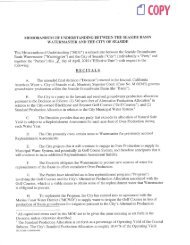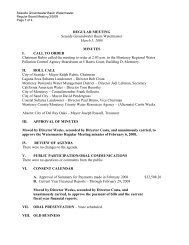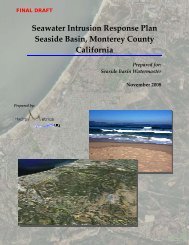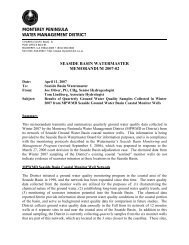groundwater flow and transport model seaside groundwater basin ...
groundwater flow and transport model seaside groundwater basin ...
groundwater flow and transport model seaside groundwater basin ...
You also want an ePaper? Increase the reach of your titles
YUMPU automatically turns print PDFs into web optimized ePapers that Google loves.
Seaside Model Report<br />
October 26, 2007<br />
Model Development<br />
of the <strong>model</strong> domain also is a no-<strong>flow</strong> boundary. Likewise, the boundary conditions on<br />
the l<strong>and</strong>ward <strong>and</strong> seaward vertical surfaces of the <strong>model</strong> domain, except for the segment<br />
of the Reliz Fault described above, are no-<strong>flow</strong> boundaries.<br />
The leakances for the specified-head boundaries were assigned so as to produce a<br />
computed head almost identical to the specified head. Accordingly, the leakances were<br />
set to a somewhat arbitrary large value. The leakances were set sufficiently large to<br />
produce nearly identical specified <strong>and</strong> computed heads, but they were set also such that<br />
the difference between the specified <strong>and</strong> computed heads was with the precision of the<br />
computer.<br />
Solute Transport<br />
Where water crosses boundary surfaces as inward <strong>flow</strong>s, due either to the<br />
assignment of specified-head or non-zero specified-flux <strong>groundwater</strong>-<strong>flow</strong> boundaries,<br />
the salinity of the inward <strong>flow</strong> is assigned. However, except for the boundary surface<br />
representing the bottom of Monterey Bay, the specified salinity equals zero. For the<br />
Monterey Bay surface, the specified salinity equals unity, which is the dimensionless<br />
concentration equivalent to seawater.<br />
3.1.6 Initial Conditions<br />
The <strong>groundwater</strong>-<strong>flow</strong> <strong>and</strong> solute-<strong>transport</strong> initial conditions is an assumed<br />
steady-state condition at the end of 1955. The <strong>groundwater</strong> development at the time was<br />
minimal at that time relative to precipitation recharge, <strong>and</strong> initial conditions were<br />
simulated based on the assumed steady state.<br />
Groundwater Flow<br />
The initial heads for <strong>groundwater</strong> <strong>flow</strong> are the calculated steady-state heads<br />
representing the long-term average annual recharge, the 1956 <strong>groundwater</strong> pumping, <strong>and</strong><br />
the boundary conditions described above. FEMFLOW3D can calculate steady-state initial<br />
heads within a transient-state simulation, <strong>and</strong> that facility was used to specify the initial<br />
heads for the Seaside <strong>groundwater</strong> <strong>basin</strong>. The resulting steady-state <strong>groundwater</strong> levels<br />
are shown on Figures 3.10a-b. Because the steady-state heads depend on the hydraulic<br />
parameters assigned to the hydrogeologic units represented in the <strong>model</strong>, Figures 3.10a-b<br />
are derived from the <strong>model</strong> calibration, which is described later.<br />
Solute Transport<br />
The initial salinity for solute <strong>transport</strong> are the calculated nearly steady-state<br />
salinity again representing the long-term average annual recharge, the 1956 <strong>groundwater</strong><br />
pumping, <strong>and</strong> the boundary conditions described above. By this construction of initial<br />
conditions, the seawater intrusion in the seaward part of the Seaside <strong>basin</strong> is assumed to<br />
be in equilibrium with the 1956 steady-state <strong>groundwater</strong> <strong>flow</strong>. Calculating steady-state<br />
solute-<strong>transport</strong> with FEMFLOW3D is not as convenient as for calculating steady-state<br />
21






